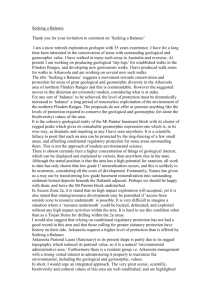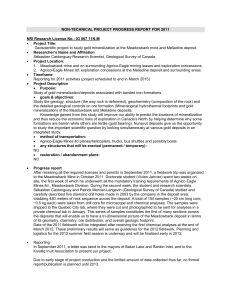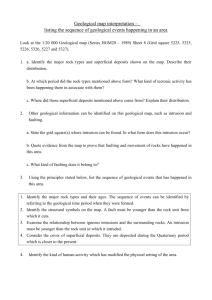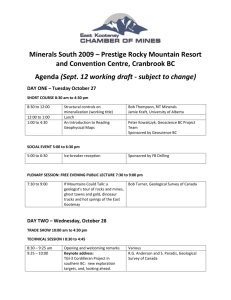APPLICATION OF LANDSAT TM DATA ... REGIONAL EXPLORATION OF LEAD-ZINC DEPOSITS
advertisement
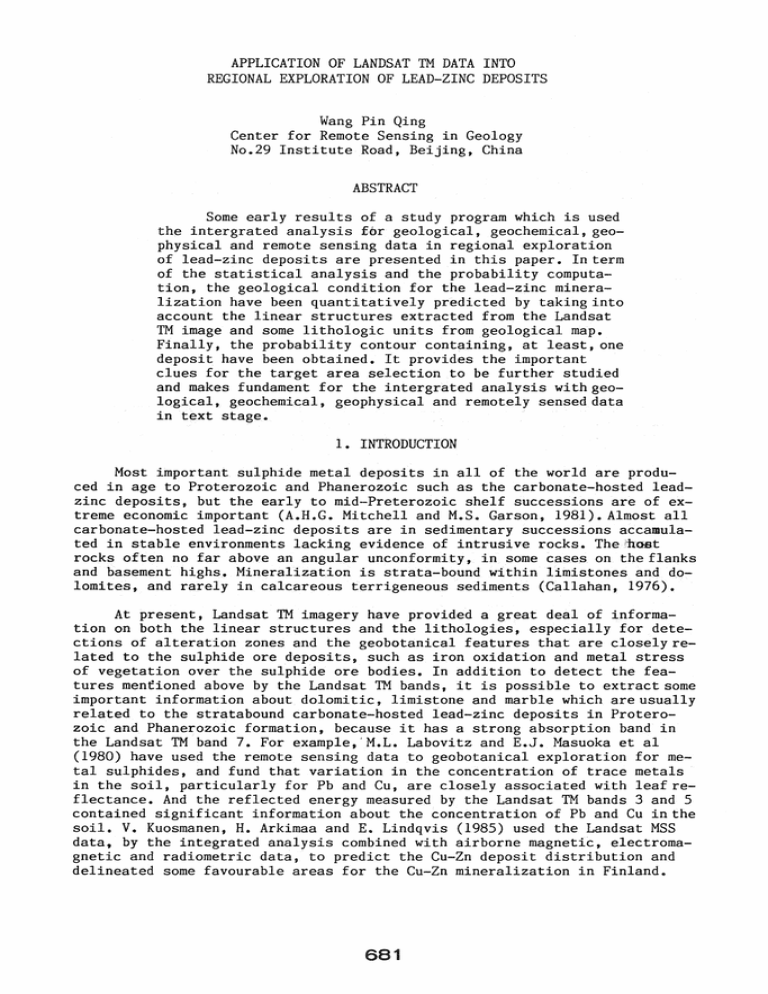
APPLICATION OF LANDSAT TM DATA INTO REGIONAL EXPLORATION OF LEAD-ZINC DEPOSITS Wang Pin Qing Center for Remote Sensing in Geology No.29 Institute Road, Beijing, China ABSTRACT Some early results of a study program which is used the intergrated analysis for geological, geochemical, geophysical and remote sensing data in regional exploration of lead-zinc deposits are presented in this paper. Interm of the statistical analysis and the probability computation, the geological condition for the lead-zinc mineralization have been quantitatively predicted by taking into account the linear structures extracted from the Landsat TM image and some lithologic units from geological map. Finally, the probability contour containing, at least, one deposit have been obtained. It provides the important clues for the target area selection to be further studied and makes fundament for the intergrated analysis withgeological, geochemical, geophysical and remotely sensed data in text stage. 1. INTRODUCTION Most important sulphide metal deposits in all of the world are produced in age to Proterozoic and Phanerozoic such as the carbonate-hosted leadzinc deposits, but the early to mid-Preterozoic shelf successions are of extreme economic important (A.H.G. Mitchell and M.S. Garson, 1981). Almost all carbonate-hosted lead-zinc deposits are in sedimentary successions accamulated in stable environments lacking evidence of intrusive rocks. The ,!hast rocks often no far above an angular unconformity, in some cases on the flanks and basement highs. Mineralization is strata-bound within limistones and dolomites, and rarely in calcareous terrigeneous sediments (Callahan, 1976). At present, Landsat TM imagery have provided a great deal of information on both the linear structures and the lithologies, especially for detections of alteration zones and the geobotanical features that are closelyrelated to the sulphide ore deposits, such as iron oxidation and metal stress of vegetation over the sulphide ore bodies. In addition to detect the features menfioned above by the Landsat TM bands, it is possible to extract some important information about dolomitic, limistone and marble which are usually related to the stratabound carbonate-hosted lead-zinc deposits in Proterozoic and Phanerozoic formation, because it has a strong absorption band in the Landsat TM band 7. For example,'M.L. Labovitz and E.J. Masuoka et al (1980) have used the remote sensing data to geobotanical exploration for metal sulphides, and fund that variation in the concentration of trace metals in the soil, particularly for Pb and Cu, are closely associated with leafreflectance. And the reflected energy measured by the Landsat TM bands 3 and 5 contained significant information about the concentration of Pb and Cu in the soil. V. Kuosmanen, H. Arkimaa and E. Lindqvis (1985) used the Landsat MSS data, by the integrated analysis combined with airborne magnetic, electromagnetic and radiometric data, to predict the Cu-Zn deposit distribution and delineated some favourable areas for the Cu-Zn mineralization in Finland. 681 2. GEOLOGIC SETTING OF THE STUDY AREA The study area of this program is situated northern part of China. In term of the geotectonic point of view, it is located in the Northern Margin of the Tarim-Sino Rorean plate. So that the most ancient basement of the Sino-Korean paraplatform is composed of metamorphic rocks of granulite facies in Archaen while early to midel Proterozoic System are mainly consisted of the green schists that are the metamorphic terriogeneous in lower part, marble or dolomitic marble and schists interbeded with schists in middel part, then overlained by the Sinian sequence platform formation as angular unconformity (see. Fig.l). Major lead-zinc mineralization in the study area are distributed~in~ the metamorphic strata system in middel Proterozoic group, in particularly in the transitional zones between the dolomitic marble and the schists in upper part. Most of them are not related to the granitic intrusive rock in spatial domains. Geological data to be existed in the area shown that the mineral deposits of lead-zinc are controlled by the fault zones in E-W and NNE directions, and associated with hydrothermal activities in Mesozoic time. Although abundant mineral occurrences there, no much of them are necessarily economic deposits to be existed. 3. DATA ANALYSIS In term of any geological factor (GF) such as the linear structures and some rock types to be quantifized by using the regionalized variable concept, it has only two possibles that the mineral deposit is either to occur or not. Therefore, one can regard them as the rare events existed in the great deal random variable for which must be obey the statistical independence condition. The assumption mentioned above is the importanttheoretical basis for this study. 3.1 Information Extraction In the first stage of the visual interpretation, a lot of linear structure information have been extracted by using Landsat TM false colour composite with band 2, 3 and 4 displayed as blue, green and red, respectively. Then, they were transfered into the topographic base map at scale 1:200000, in order to match with the geological map to be used in this study (see Fig.2). Finally, all linear structures in the area have been divided into four groups, by refering as to the rose diagram (see Fig.3), as shown in table 1, and compiled the thematic maps corresponding with them. The major aim of this work is to respectively inspect0 the probability of each group for lead-zinc mineralization. As mentioned above, the lead-zinc mineralization in the area are, in general, associated with and/or controlled by carbonate and terriogeneous sedimentary formation, so that they were extracted from the conventional geological map, and also compiled the thematic maps. Thus, a series of thematic maps for the geological factors that are closely related to thel:ean~ zinc mineralization in the area have been established in this way. 3.2 Quantifized Geological Factor (QGF) Quantification of the geological factors above is realized byinv~~~rrg the regionalized variable concept in geostatistics (cf. Wang 1987). For the linear structures t the random variable values n are determined by the num~:" ber of the linear structures to be occurred in each grid while the strata 682 groups mentioned above can be quantifized as subdivided the grid into a serise of rectangular cells in it. In this study, the grid size of 6 KM by 6 KM have been used because the major purpose in the first stage of the study is to make prediction for the geological condition for the lead-zinc mineralization in the area. 3.3 Probability Computation In the context of the geostatistics, the lead-zinc deposit occurrence relative to the geological factors to be quantifized as method mentioned in previous section, such as the linear structures in different direction and carbonate strata group, are the rare events. Suppose the probability that lead-zinc mineralization will occur in the random variable N is p. Let q = 1 - p denote the probability that it will fail to occur. Now. we have obtained the independent random variable n in each grid, and denote by x the number of occurrences of lead-zinc mineralization obtained in the n varia~ bles. Thus, the resulting probability, which is the probability of containing x mineralization in n independent variables of an event for which p is the probability of occurrence in a single variable, defines what is known as the Binomial-Bernoulli frequence function. Consequently, ( x = 1,2,3~ ••••• o where: p n x n ) •••••••••• ( 1) <p <1 = probability value in each geological factor group = the random variable value in the grid = number of mineralization to be occurred in the grid In this study, the necessary parameters Pi in equation (1) have been respectively fund by using the Maxmum Likelihood estimate method. Table 1 Ta bl e 1 . The Stat1st1caI Parameters 1n t he Stud ~eter group GF 1 (270°-315°) GF 2 (320°-360°) GF 3 ( 0°_30° ) GF 4 ( 35°-90° ) GF 5 Pt-Carbonate GF 6 Pt-Terreg lY N M Area probability Pi = MIN 141 18 0.127 171 23 0.135 142 17 0.119 177 19 0.107 67 24 0.358 38 14 0.368 lists the statistical parameters above. Therefore, the 6-D probability space for the geological factors to be extracted above have been established in this way. 683 However, it is well know that one can used the Poisson approximation to depict the probability distribution above when the probability value is very small or the random variable is large enough. So that, the probability function satisfied the assumption above can be expressed as follows: -3\,.c p (x) == e ( x == -vrx. 0.1.2.3 n ) • ••••••••• (2) o <p <1 In fact, we have theroreticaly verified that the occurrences for leadzinc mineralization in the area obey the Poisson distribution function by using chi-square test. For example, Table 2 shows the chi-square test parameters for mineralization occurrences in the carbonate group, and result shown thef(O.05 (1) == 3.841 > 2.40 so that the assumption can be accepted. Table 2.?(2' Test Parameters for Carbonate Group ft=np fr (ft-fr)2 (ft-fr)2/np 0.737 43 41 4 0.093 1 0.221 13 11 4 0.307 2 0.033 2 4 4 2 3 0.0016 0.094 2 4 0.0002 0.012 1 x p 0 5 0 0 =2.40 In order to compute the total probability for the 6-D probability space, we have invoked the General Binomial Distribution Function (GBDF) in this study, that is: Pt = PI + P2 + P3 + P4 + P5 + P6 • ••••••••• (3) o<p <1 Since the aim of this computation is to predict the geological condition of the lead-zinc mineralization in the area, so that the total probability of occurring at least one mineralization in the six random variables of each grid can be rewritten as follows: • .......... (4) o<p <1 The equation (4) does not only provide the evaluation about contribution of each geological factor to the mineralization, but also take into account their combination relation in each grid. Finally, the computatio!l:::-te.sk.:_J,fi th equations (2) and (4) have been carried out in M - 160 computer system in grid by grid, and produced an probability contour map corresponding with them. 684 4. DISCUSSION AND CONCLUSION Through the statistical analysis and the probability computation above, the probability contour of occurring at least one lead-zinc mineralization (see Fig.4) have been obtained. It only provides a quantitative prediction for the geological condition of lead-zinc mineralization in the study area, because we take merely into account the informations about linear structures and some specific strata system to be respectively extracted from the Landsat TM data and the conventional geological map. However, this probability contour shown some important clues for the target area selection of lead-zinc exploration at regional scale, and provided neccessary basic data for the intergrated analysis with geochemical and geophysical data in next stage. By the comprative analysis with lead-zinc anomaly shown on the geochemical map, the probability anomalies such as LZ-P-I, LZ-P-II and LZ-P-III in Fig.3 are completely consistent with them, but the area of the probability anomalies are in general large than the geochemical anomalies because mapping scale and grid size to be used in this study are seriousely restricted. On the other bands, most lead-zinc mineralization sites are almost occurred within these probability anomaly regions, only a few mineralizations that these are perhaps related to the granitic intrusives and hydrothermal activities in the Mesozoic time are located outside the anomalies. As mentioned in previous sections, the geological factors related to magma active are not considered in the model of this study, since major purpose of this study is to search the stratabound carbonate-hosted lead-zinc deposits in the Proterozoic successions. In this study, although we had attempted to extractc' some information about carbonate formation in I 2 S 101 image processing system with Landsat TM bands 4, 5 and 7, no successfule results have been obtained because the study area are covered by the soil and vegetation. In summary, the method deseribed in this paper is useful for the mine~~ ral exploration at regional scale with the help of the remotely sensed data, especially with the Landsat TM data due to it's additional bands in the reflective infrared region as well as the superior spatial resolution to the Landsat MSS data. But the major contribution of remote sensing to regional geological study and mineral exploration is, so far, to provide great deal structure information, so that geologists have to use some statistical methods to evaluate the relation of mineral deposits to the lineat structures shown on the remote sensing imagery. The results of this study had provided an important basic clues for targe area selection in lead-zinc exploration at regional scale and laid on fundament for the intergrated analysis with geochemical and geophysical data. ACKNOWLEDGEMENT Author would like to thank Misses Hong Jie and Chen Suwen who had professional drawn the diagrams in this paper. REFERENCES 1. M.L. Labovitz, E.J. Masuoka et al; 1983. The Application of Remote Sensing to Geobotanical Exploration for Metal Sulphides - Results from the 1980 Field Season at Mineral, Virginia - Geology •. V.78, No.4, pp.750-760. 2. A.H.G. Mitchell and M.S. Garson; 1981. Mineral Deposits and Global Tectonic Settings. 3. V. Kuosmanen, H. Arkima and E. Lindqvist; 1985. Structural Positions of 685 4. 5. 6. 7. 8. Predicted and Known Cu-Zn Ore Indications -Proceedings of the International Symposium on Remote Sensing of Environment - The Fourth Thematic Conference: "Remote Sensing for Exploration Geology". V.I. pp.57-71. S.J. Fraser, J.F. Huntington et al; 1985. Discrimination of Iron Oxides and Vegetation Anomalies with the MEIS Narrow Band Imaging System - Proceeding of the International Symposition on Remote Sensing of Environment - The Fourth TheMatic Conference: "Remote Sensing for Exploration Geology" V.I. pp.233-253. Li Chunyu, Wang Quan, Ciu Xueya and Tang Yaoqing; 1982. Explanatory Notes to the Tectonic Map of Geological Sciences. pp.9 P.G. Hoel; 1955. Introduction to Mathmatial Sitatistics. Wiley. NT. pp. 62-64. G.F. Bonham, Carter and A.N. Rencz; 1985. Spatial Relationship of Gold Occurrences with Lineaments Derived from Landsat and Seasat Imagery, Meguma Group, Nova Scotia. - Proceedings of the International Symposium on Remote Sensing of Environment - The Fourth Thematic Conference: "Remote Sensing for Exploration Geology", San Francisco, California. 1985. pp. 755-768. Wang Pin Qing; 1987. Predicting the Location of Kimberlite from a Probability Analysis of Linear Structure on Remote Sensing Data. - INT. J. Remote Sensing. V.8, No.3, pp.417-426 686 ~ Granite I~--:.:. , I Upper terrigenous group /-~ I Lower terrigeneous group- [ill] Gneiss fVYYl Andsite " I I n Carbonate group ~ 1====== Fig.l .. Ill.. Geological map of the study area. 687 Fig.2. The map of linear structure distribution is interpretated by using the Landsat TM data. Fig.3. The rose diagram of the linear structure. 688 km~'--_ _...L-_ _...J~km Fig.4. The probability contour of containing at least one lead-zinc mineralization. 689




